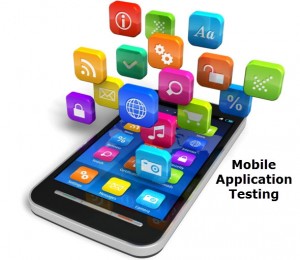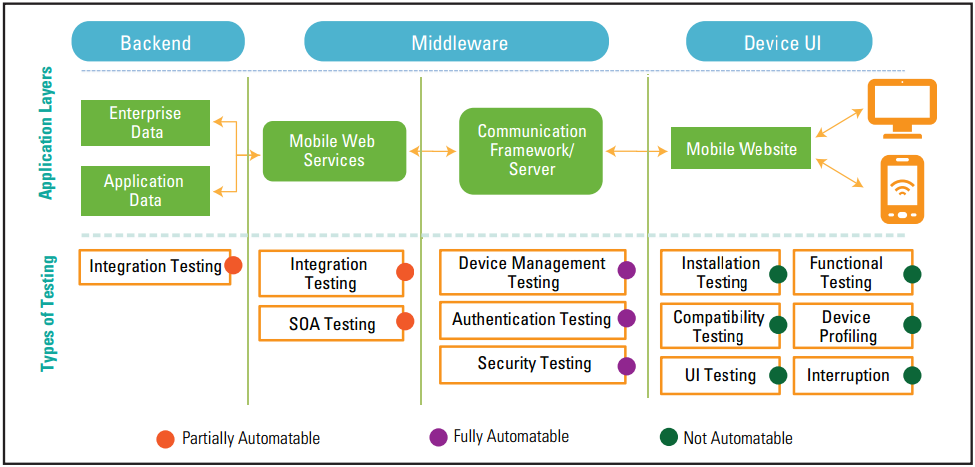In the fast-growing world, the mobile phone is not only a device to make and receive telephone calls but also a multipurpose personal gadget. There are more technological improvements and the propagation of mobile devices with different Operating Systems like Apple iOS, Andriod, Windows Phone, Blackberry, Symbian, etc. In the fast-growing world, there are new challenges for hardware manufacturers to stay in the competition. Also, the application developer needs to deliver the best Apps over a variety of platforms within a quick time.
What is Mobile Application Testing and Why it is needed?
In a highly fragmented and competitive global market the mobile development cycle is of a short period. For the vendor’s equanimity and overwhelming task to ensure long-term success, the APP must be tested over a different combination of platforms, operating systems and networks before launching to global. In addition to this, similar to Functional testing the non-functional testing like Security testing, usability testing, etc. also plays an important role. The effective test planning in Mobile Application testing makes helps to improve the quality of Mobile Apps.
In this article, we are exploring how to achieve mobile application quality and get better competence in mobile testing. We are also learning about what Mobile Automation is and what the challenges in Mobile Application Test Automation? Many testers are confused about Approaches for Native and Hybrid Mobile Apps, so this discussion will shed some light on this as well. In the market there are different varieties of Mobile Automation Tools available, however, each mobile automation tool has its own advantages and disadvantages. As a result, we will see “What are the Key Principles for selecting the right Automation tool for Mobile Apps Testing?”
The mobile automation testing is an extremely effective approach to test the Mobile Applications which gives us considerable returns if you choose the right tools for mobile testing automation.
Key Mobile Testing Challenges in mobile testing tools Automation
The primary factor that determines an automation tool’s success is its ability to work across platforms and technology stacks. The following challenges influence automation success:
For all companies, Mobile applications become a “game-changing” force in all industries. Let’s look at what all challenges introduced these game-changing technologies:
Planning of Quick Rollouts
The companies are looking for golden business opportunities in unique Mobile apps. Expecting a rapid rollout of quality application or improvements and bug fixes if an application is already launched. They want to push the applications in the market quickly to avail of the benefits of a market boom-mobile sector. The QA testing cycle which generally takes 2-3 weeks depends on the complexity and the size of the application. It is now reduced to half or one week. Due to clutch in the timelines, it is very difficult for problems if mobile applications don’t meet customer expectations.
Multi-Platform Compatibility
With the propagation of mobile devices like iPhone, iPad, Smartphones, Tablets, Windows Mobile and a wide range of Andriod devices, etc, mobile application providers have to provide the multi-platform compatibility to reach their audience. In the mobile industries, there are no industry standards for Operating Systems or device hardware. So testing apps over a variety of devices is not a simple task. We cannot 100 % say that test cases that passed for one device passing for other devices.
There are many combinations while testing mobile apps like Screen resolution, memory sizes, battery, Operating System, etc. The creation of separate test cases and execution on each device can be the most expensive and time-consuming task.
The mobile application market is rapidly growing with a demand for a quality product. Also no excuses for errors and security holes.
Dealing with a variety of connectivity modes
One more important parameter to be considered in mobile testing is the “Modes of Connection” to access the application. This step can be ignored if the internet connection does not require an application under test. However almost all applications require the internet so this test case needs to run over different connections like WiFi, 3G, 4G, etc. Even you test the application you will face a wide range of applications over different connectivity options. While planning your QA Automation testing strategy you need to consider connectivity modes which are equally important
Creating end-to-end tests
The mobile market demand is to integrate mobile applications with all platforms. And it is expected to flawlessly access the data on mobile and another platform like a Web site. The end to end test cases should be work as expected on mobiles. Consider an example where the order is placed from the mobile device and the same can be from the login into a Web site. These mobile apps are expected to work on front-end and back-end systems.
Mobile Testing Tools Availability / Selection of Mobile Automation testing tools
We have many proven tools available for object recognizing screen object on the web. For mobile devices, there is a range of automation testing tools, however, choosing of right automation tool for testing plays an important role in QA strategy planning. (In the next article we will see the list of good automation tools.)
Approaches for Native and Hybrid Mobile Applications
In mobile testing, you can use different approaches
Mobile App Testing on Cloud
To test mobile applications use of Cloud testing is one of the most successful choices. Using a Cloud-based approach you can achieve the Native and Hybrid Mobile Apps automation testing. This automation testing approach is used when long-term automation testing. It is to be carried out over multi-platform and predefined set of devices. Cloud-based automated solutions are highly effective as they are offered as a unified package. Once the deployment is done in the cloud lab then you just needed connectivity to the cloud lab to kick off your testing from anywhere.
Using a Cloud-based approach will reduce the time to set up the test environment which generally causes the project delays. The cloud provides a pre-configured, highly synchronized architecture, strong server configurations, licensing, and testing resources. As a result, reduced time-to-market and augmented testing competence. So defects get rapidly reduce which may occur due to the faulty configuration of test environments. It helps to increase the quality of the application.
One of the great advantages of the cloud approach is the amount of scalability with real-time results, which means defects can be analyzed while the tests are running.
[Click on image to enlarge image]
Lab-based Approach
In Lab-based automation testing, you need to set up different tools in a testing environment and leverage simulators or physical devices to automate testing using different tools. In the market there are different capability tools are available for a lab-based approach like EggPlant, Jamo, See Test, ZAP, and SilkTest, etc. These automation tools can be used for continuous automation testing or to accomplish regression testing functionalities. Few of them also support the non-functional testing features related to mobile apps.
Open Source/Platform-specific Tools
In the QA automation testing strategy the testing to check platform-specific tools reliability should be carried out at least once. There are different mobile testing tools available in the market like Appium, Calabash, Frank, MonkeyTalk, iOS UI Automation, Robotium, iOS-driver, Ui Automator, KeepItFunctional and Selendroid, etc. But before starting testing on Open Source/Platform-specific Tools you should have added programming skills to your team. Also, the mobile device simulators and emulators can be used for testing.
Advantages of Mobile Test Automation
- Same test scripts can be executed repeatable
- Help to increase the testing efficiency
- Help to enhance the regression tests case execution
- Multiple test cases can be executed with less time
- Better utilization of time by running test script over 24/7 time.
- Test scripts can be executed parallel on several devices at the same time.
- Once the test scripts are ready, human resources do not require manual interruptions to execute the scripts.
- The same test cases can be executed across different mobile platforms, so the scripting time can be minimized and the same time can be used for more test coverage.
Conclusion
In this article we conclude the following few points:
We need to think of a perfect automation strategy to execute a successful QA and helps to get a mobile application on time and on budget.
We need to find the mobile testing automation tool which can help you to execute the same test script across platforms. As a result, the scripting time can be minimized and at the same time can be used for more test coverage.
We need a mobile automation tool where you can configure a test set for a different device to test out the application over a variety of connectivity modes.
The tool should be platform-independent and allow you to create true end-to-end testing with a single test script possible.
About Author: This is a guest post by Poonam Naimbiar. She is working as QA Lead, in one of the MNC located in Pune. She is passionate about her testing career and having an overall 7 years of experience, out of that 3 years of mobile testing for websites.
Have you ever get a chance to work on Mobile Apps Testing, please share your experience in the comments below.
In the next article let me take deeper dive into mobile testing approaches in the article “5 Testing Approaches For Making Successful Mobile Apps”.
⇓ Subscribe Us ⇓
If you are not regular reader of this website then highly recommends you to Sign up for our free email newsletter!! Sign up just providing your email address below:
Happy Testing!!!
- Tutorial 4 – Types of Mobile App Testing
- Mobile Testing Tutorial Series – Tutorial 1 Mobile Application Testing Strategy
- Mobile Testing Challenges and Solutions – Tutorial 3
- What is Exploratory Testing?
- What is Globalization and Localization in Software Testing?
- Security Testing approach for Web Application Testing
- Detailed Understand of Usability Testing: What? Why? & How?
- Top 5 Mobile Automation Tools to Test Android Applications
- Mobile Testing Tutorial 6: Beginning Guide Of iOS Testing
- What is a Crowdsourced Testing?



15 thoughts on “Tutorial 2: Introduction to Mobile Testing Application”
Can you please suggest one good open source tool for mobile test automation? Please post next article early…
Your tutorial is very useful for us but i want know some practical examples to learn testing as soon as posible Thank You
Thanks for posting on Mobile Application and explaination is good.
Awesome article, You made tester as professional, very interesting article, Thanks a lot
Nice article, explained in very practical way.
This is very nice article,
I am using calabash automation tool for Android OS & if any body need some help pls feel free to ask me.
Thanks, CM
Hi, I am new to Appium tool. Can you please share the details on Appium tool.
Awesome post. I was waiting for this for long period of time.
Thanks for sharing valuable information on this website.
very help full and thanks for taking on :)
Your tutorial is very useful for us but i want know some practical examples.
your article is good i need a practical examples
Nice Article.
hello
Sir/Mam
i started my career as mobile app tester in small start-up company.
please tell me about the growth in mobile apps testing.
Hi,
I’m newly entered into mobile application testing though i’ve plenty of experience in web/desktop app testing. This mobile app testing tutoril is really useful for me and provide some good approaches. Thank you for all the efforts that you put in.